





The following article is a discussion, from a personal experience point of view, of the Echeverias. I have grown dozens of Echeverias in pots and in the ground in Southern California and consider them one of the best and easiest plants to grow in this climate. There are hundreds of Echeveria species of which only a fraction are available in cultivation, but I have tried to grow many of these available species (though I certainly have not tried them all). In addition the the species, there is a seemingly infinite number of Echeveria hybrids available and I will discuss a few of these as well.
Echeverias are mostly Mexican natives (some live in Texas and South America, too) in the family Crassulaceae, a large family containing many common recognizable genera of succulents often encountered at nurseries and home gardening centers. Most Echeverias grow in higher elevations in Mexico where the humidity is low and the temperatures rarely get exceedingly hot. Soils are invariably well draining and some species live only on cliff faces and steep slopes where excess water drains off anyway. These are not tropical plants.
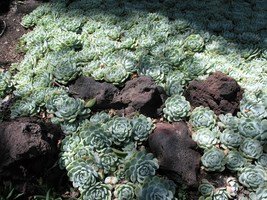
Echeveria elegans growing among the rocks in this botanical garden, similar to how it might in the nature
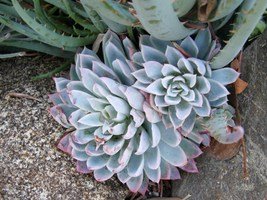
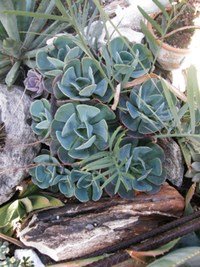
unknown Echeveria crammed between rocks- they seem to like be crammed into tight places; Over the last three years this turquoise plant in the last photo has slowly spread and has made a wonderfully attractive ground cover, but it has not out-competed with the surrounding plants... Echeverias make very 'easy' and 'friendly' companion plants, rarely crowding out other plants, but also not caring if they pushed aside a bit.
In general these are inexpensive easy plants, popular mostly because of their ornamental flower-shaped, thick-leaved succulent rosettes and wonderful colors and textures... but their low cost certainly helps, too. Most Echeverias are suckering plants, eventually forming small (or large) colonies of closely growing plants. This suckering/offsetting behavior makes them particularly ornamental pot plants as, in time, most will offset enough to completely fill a pot, often spilling over the edges and making living bouquets of succulent rosettes.
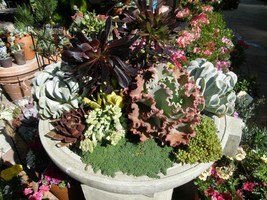 Echeverias and other succulents expanding in a community pot
Echeverias and other succulents expanding in a community pot
Some Echeverias have the unfortunate common name Hens and Chicks, which is also the name for all Sempervivums (another member of the Crassulaceae), another rosette-forming genus that often gets confused with Echeverias. This unfortunate confusion leads to an endless misidentification problem in the Davesgarden plantfiles as one genus gets uploaded into another's files over and over again. Echeverias are fairly hardy succulents compared to most perhaps, but they are total wimps compared to the cold temps Sempervivums can endure (well below freezeing in most cases). Echeverias are, for the most part, frost tolerant, but few can survive a deep freeze for any length of time and zone 9a is about the limit for the most cold tolerant species. Sempervivums can survive living in climates where it snows all winter. On the other hand Sempervivums cannot tolerate the heat Echeverias can (I keep learning that lesson over and over, sadly). So knowing the difference will help one avoid a lot of disappointment when gardening with these two genera of succulents.
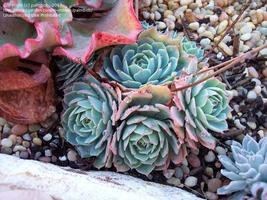
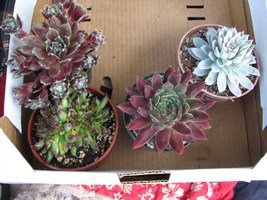
Echeverias on the left and Sempervivums (along with an Echeveria in blue) on right, showing similarities
Some Echeverias can mimic Sempervivums very closely so I understand the confusion sometimes. But when in doubt about what genus one has in one's collection, all doubts will vanish as soon as the plant flowers since the two genera have very dissimilar flowers. Echeveria flowers are not fuzzy, are often arching and the flowers themselves are quite succulent and bell-shaped. Sempervivum flowers are non-succulent and usually pink with thin, narrow, aster-like petals often on oversized inflorescences. And if still not convinced, one only need wait for flowering to end, as most Echeverias flower yearly while Sempervivums are monocarpic (die after flowering). A few of the more spectacularly flowering Echeverias seem to be monocarpic as well, at least in my care, but these are not usually species easily confused with Semperivums.
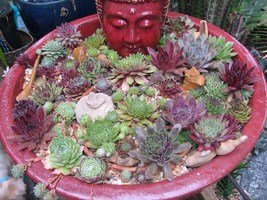
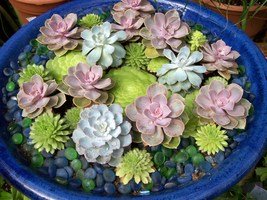
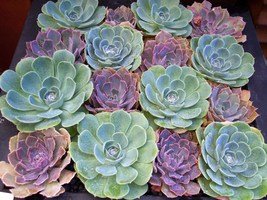
Bowl of Sempervivums California Cactus Center creation with Echverias, Aeoniums and Sempervivums.. and another CCC creation with only Echeverias
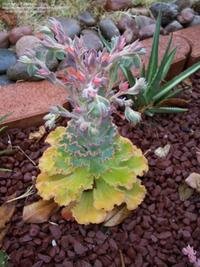
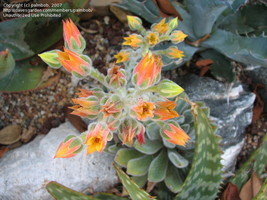
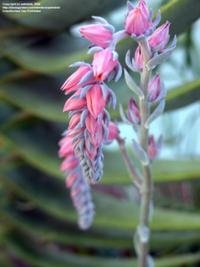
examples of Echeveria flowers
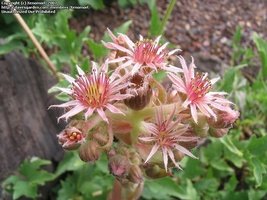
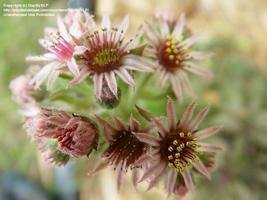
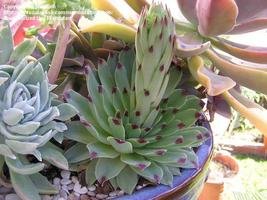
examples of Sempervivum flowers, and one of my own Sempervivum calcareum flowering early- these look nothing like Echeveria flowers!
I am not certain whether coastal California is the most perfect climate on earth to grow most Echeveria species, but it certainly is a good one. One can look like a master gardener when growing these plants in this climate. Most are very easy and, thankfully, resilient plants, tolerating most frosts, some heat, full sun, full shade and various and sundry watering strategies (another way of saying they can tolerate someone like me watering too much or too little and doing both routinely).
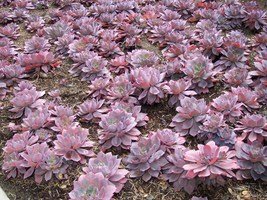 Echeveria hybrids growing great in Los Angeles yard
Echeveria hybrids growing great in Los Angeles yard
In general, Echeverias, though drought tolerant plants in general, seem to look best when it's not blazing hot out. Most of mine look great from about October through June, and then many have a few months of unhappiness when the temps get over 100F. Most prefer full sun, which makes it hard when it gets too hot. Though I have not had too much problems with plants grown in partial shade, full shade plants tend to get etiolated (stretched) and weak, often supporting healthy crops of mealy bugs or fungus. The colors of shade-grown plants is far less interesting, too, with most being an abnormal shade of green. Echeverias do NOT make good house plants, primarily due to the low light levels in most indoor situations (even window sills seem too dark for most plants)... and the lack of air flow indoors allows for the 'spontaneous' appearance of mealy bugs and other pets
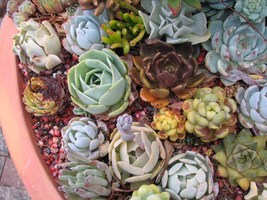
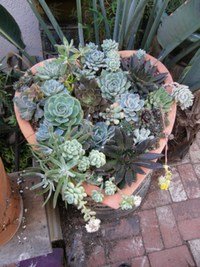
Echeverias in one of my pots curled up and a bit fried from summer heat; here is a shot of same plants a year later showing amazing ability to recover from damage, and how being crammed in a tight space affects very few of them negatively (not all plants in this pot are Echeverias- some Dudleyas, Sedums and Sempervivums, too)
Winters here in coastal and southern, inland California are not usually a problem for most Echeverias commonly encountered in cultivation. All seem to tolerate a mild amount of frost down to about 27F or more, sometimes with some visible damage and sometimes not. Some species are more cold sensitive and completely melt under such lows, but I have only discovered a few of these species. It never gets cold enough here in my yard to test the absolute cold minimums of many Echeverias but I think 20F would be close to the minimum temps most could survive.
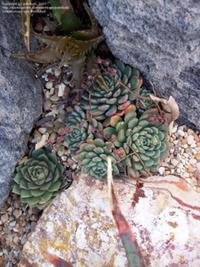
Unknown Echeveria in my yard survived temps down to 25F for nearly 8 hours unscathed despite aloe species right next to completely melting and dying
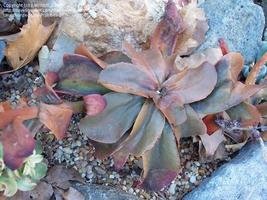
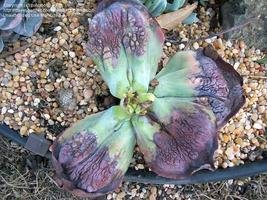
Echeveria hybrids seem more sensitive to cold. Both plants amazing survived, but it took them half a year to recover from freeze damage
Heavy rains in winter seem also to not be a problem with most Echeverias, at least in my experience. These plants are supposedly dormant this time of year but in my garden they seem happy and sure don't look dormant, and just suck up the pure rain water greedily. Excess water in the heat of the summer, however, is often NOT always a good thing. As it virtually never rains here in summers, I have no idea if rain water would be less of a problem, but I suspect not, as rain is usually associated with less than baking temperatures, and it's the combination of searing heat and water that seems to do a lot of Echeverias in. However, books I have on succulents suggest watering Echeverias heavily in summers. So you may have to experiment on your own.
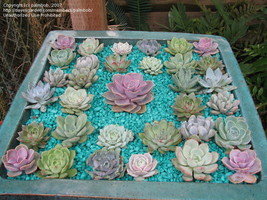
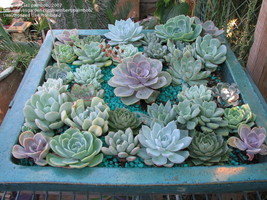
Two shots of platter in our yard before winter, and after winter showing indeed these plants do grow in cold weather
The main growth time for Echeverias is the spring, and that is when most of mine crank out their flowers (though some flower off and on all year long). This is the time when water is indeed needed.
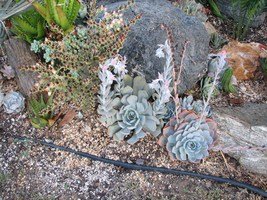 Echeverias in my yard flowering in spring
Echeverias in my yard flowering in spring 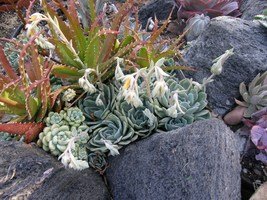
If grown in pots, Echeverias need to be repotted now and then, as many are aggressive growers and can quickly suck all the micronutrients out of the soil, and fill the pot with roots, requiring new soil every few years (though mature plants grow slower and need this less often).
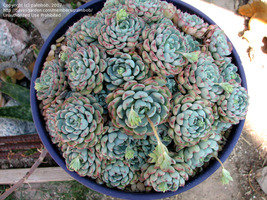 unknown species filling pot in my yard
unknown species filling pot in my yard
As Echeverias grow, the lowest leaves die and either fall off, or just start building up as a dried layer of brown or tan crinkled flattened strips. This can look unsightly, and be a good place for bugs to start collecting, so removing the dead leaves, if possible, is usually a good idea.
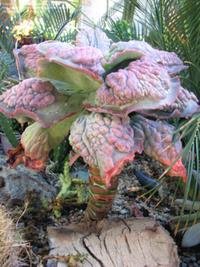
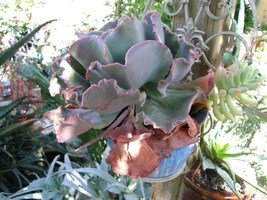
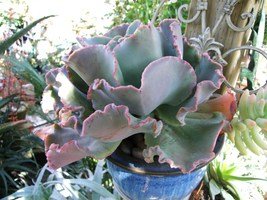
Echeveria 'Barbillion' growing a thick stem... soon after this, the entire stem collapsed and I had to reroot the top; other two photos show a hybrid Echeveria with dead leaves, and then how much nicer it looks with leaves removed
I do have a few consistent problems with Echeverias. The most common problem are pests. These are particularly numerous in my garden, though I have not formally invited any of them. Aphids seem to be particularly attracted to Echeveria flowers (or any of the more succulent Crassulaceae flowers) and can do significant damage if not treated (I sometimes hose them off... but Echeveria flowers are pretty delicate and I often will hose off the entire flower if not careful... if not too lazy and no pets in the immediate vicinity, I do use a little spray pesticide now and then... keeps the aphids off for at least 3-4 days). I am convinced aphids appear spontaneously at of thin air. The aphids seem much less interested in the rest of the plant and plants not flowering rarely seem to have any aphids on them. But as soon as a flower pops up, it is immediately covered with a large crop of yellow aphids. Where on earth are they hiding, if it's not the thin air?
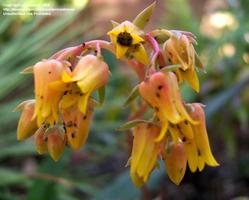
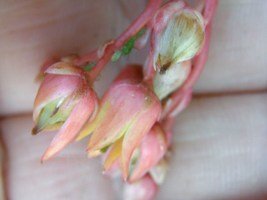
Echeveria agavoides and Echeveria colorata flowers frequently covered with aphids
Another common pest is mealy bug, though this is mostly a problem in shade-grown and constantly moist plants (the two go hand in hand as those in the shade don't dry out so fast). Mealies can kill a Echeveria in no time, and do the same to Sempervivums and Haworthias (all the smaller rosette-type succulents) if not caught and treated in time... not sure the bugs themselves kill the plants or just allow an access for fungus to kill the plant.
Slugs also seem to like Echeverias and can make them look unsightly (though rarely kill them). Grasshoppsers also take a nibble out of one now and then.
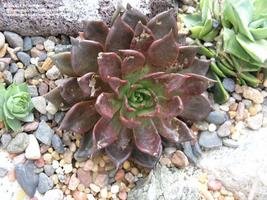
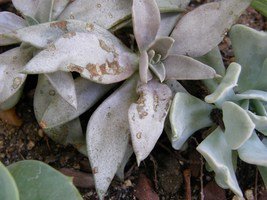 Slug damage
Slug damage
In my garden I have a few vertebrate pests- my own parrot seems particularly fond of munching on Echeverias (thank goodness they do not appear to be toxic), as do the neighborhood squirrels (I wish they WERE toxic to squirrels). Both these vertebrate pests love to nibble off the leaf tips only, and rarely outright kill the plant... but sure sets them back a year or two.
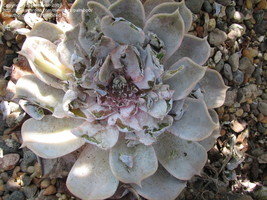
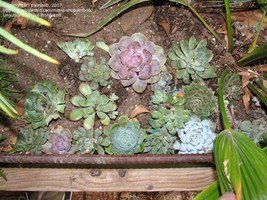
Echeveria lilacina and Parrot damage (from my own pet); this group of hapless Echeverias has been munched on multiple times by a family of squirrels (over half are dead and gone at this point)
But in general my Echeveria collection seems pretty unharmed by the environmental factors (heat, sun, rain, cold, pests) over the years and though not super rare or anything, these are one of my favorite landscaping and potted plants. But sometimes I have a problem with splitting leaves or sudden rot- I think this is due to excess watering during times of high heat or too much cold.
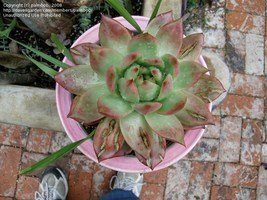
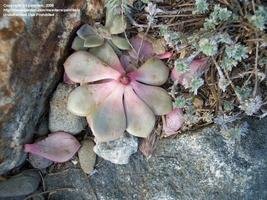
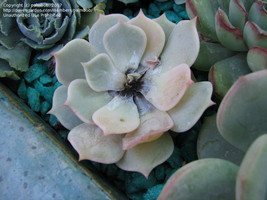
Echeveria colorata with leaf split; Echeveria hybrids Perle Von Nurmberg and Lola suffering from rot after watering in summer heat
The following are few of some of the more common species/hybrids I grow in my yard (or have seen repeatedly at succulent shows). This is certainly not an exhaustive list, and I am embarrassed to say I cannot identify all the Echeverias in my yard. In fact, many simply look too similar for me to tell them apart at all. But I am not alone, as Googling many of these species I find many other growers are just as confused as I am, with many mixing up several of them and many more being misidentified over and over again. The reason for some of the confusion is even in the wild many populations of the same species look very different. And just in my yard, the same plants grown in different situations can be so different it is hard to believe they are the same species. Plus Echeverias hybridize easily in the wild as well as in cultivation, so one often has no idea what one has, even when one has the parents.
Echeveria agavoides is a very ornamental species with thick pointed bright green leaves tipped in red. Many cultivars of this species are grown with exaggerated dark contrasting reds to purples at the leaf tips. This species can grow up to 10" across and tends to sucker more slowly than some. This one also seems to tolerate more shade than most, though full sun plants tend to have more interesting color but can get a bit yellowy in hot, blazing sun.
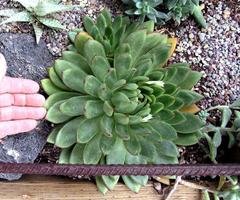
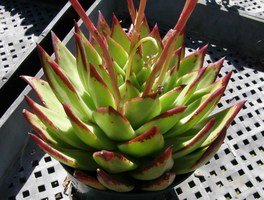
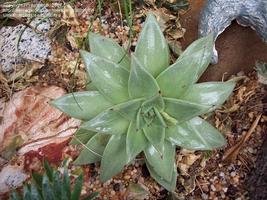
Echeveria agavoides grown in mostly shade, and one if full sun; last photo of a hybrid of this species grown in more shade than it should be

Echeveria agavoides variety prolifera, outdoors in the Huntington Gardens, southern California
Echeveria colorata is a nice beefy looking species with large, thick rounded leaves similarly tipped with pinkish reds like Echeveria agavoides is. This plant is a great full sun species having no problem with even the hottest days here in the San Fernando Valley outside Los Angeles where it often gets into the low hundreds.
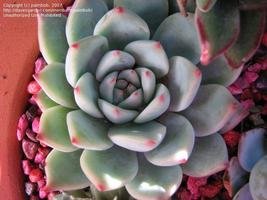
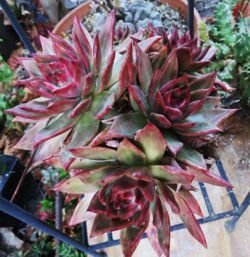
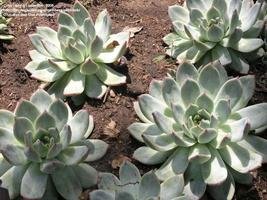
Echeveria coloratas in my yard Echeveria coloratas in 100+ heat of Los Angeles county
Echeveria coccinea is a fuzzy-leaved species with ovoid light to deep green leaves. As with some of the other fuzzy-leaved species, this is a branching species that rapidly develops woody stems. Pruning this species back can keep it from getting too ‘leggy'... but plants in the ground in full sun can form attractive, low-growing shrubs several feet wide.
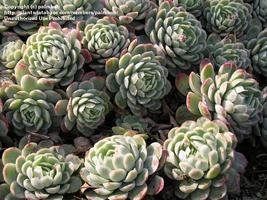
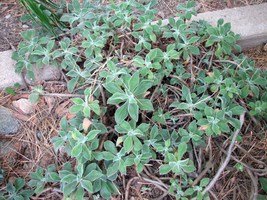 Echeveria coccineas
Echeveria coccineas
Echeveria elegans is one of the more common species in cultivation and I certainly have several of these in the yard... but I could not tell you for sure if all the ones I think are Echeveria elgans are in fact that species (many other species look similar). This is the classic light green, ‘rose'-shaped clumping Echeveria about 3" across (more or less) with rounded, smooth, succulent leaves, and making small, arching inflorescences with bright orange flowers. This species is not only a common one in many collections, but it is a common one used in hybridization with many botanical gardens having attractive hybrids of this species in their collections.

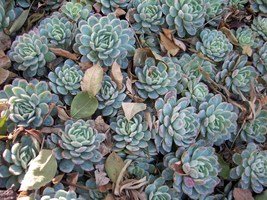
Echeveria elegans in large garden areas
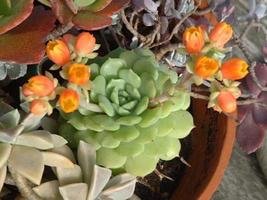
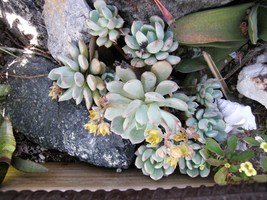
Echeveria elegans in pot (photo by Ulrich- thank you!) and in my garden

Echeveria elegans mass planting outdoors, southern California, during spring and flowering season
Echeveria gibbiflora var. metallica (aka Echeveria metallica) is another favorite of mine. This variety of Echeveria looks very little like other Echeveria gibbifloras (a somewhat generic genus of wavy, wide-leaved Echeverias more commonly used for hybridization than grown for cultivation) with lancelote weirdly purple-grey leaves that have a definite metallic look to them. Inflorescences are massive with dozens of pale orange flowers growing on the many arching branches. This plant seems to be somewhat monocarpic (if there is such a thing as ‘somewhat' monocarpic) as the huge inflorescence seems to take most of the life out of the mother plant turning it into a stumpy-looking ghost of its former self while the offsets take over.
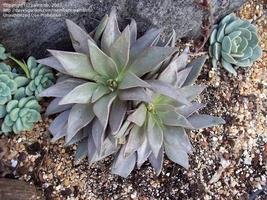
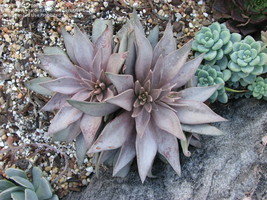 same Echeveria metallica/ different seasons
same Echeveria metallica/ different seasons
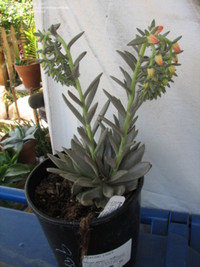
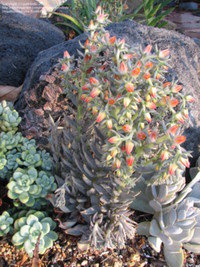 Flowering in pot and in yard
Flowering in pot and in yard
Echeveria lilacina is another favorite of mine being nearly pure white (making great contrast in gardens with dark bedding or top dressing). Rosettes get upwards of 10" or more across and flowers are a pink orange on very tall, arching stalks. This species is also a favorite of my parrot unfortunately.

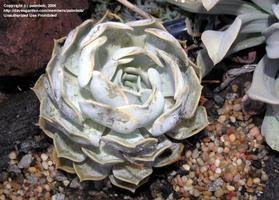 Echeveria lilacina spring and summer heat
Echeveria lilacina spring and summer heat
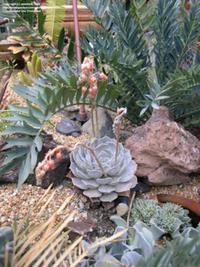
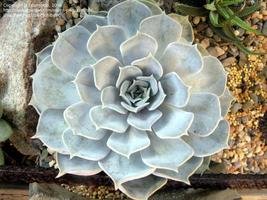 Echeveria lilacina flowerig; top view
Echeveria lilacina flowerig; top view
Echeveria harmsii is another wonderfully fuzzy-leaved species that has striking colors in times of stress (if not watered excessively, that can be nearly all the time). The leaves are blue-green and are tipped with various shades of red, pink, orange and even purple. Like some other fuzzy-leaved species, this one can get leggy and need to be pruned back yearly.
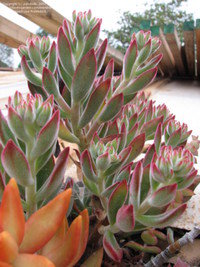
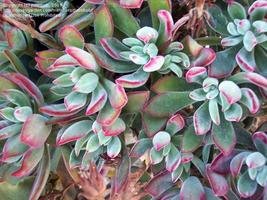
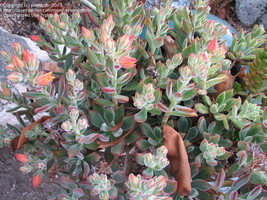
Echeveria harmsiis in my yard
Echeveria nodulosa is a weird species with pale green leaves and ‘painted-on' red lines. The first time I saw this plant I was sure it was fake. I am not sure why this is not a more popular species... it is not always easy to find, but it does not tend to be pricey. Eventually it grows a tad leggy and can require trimming back... but the leaves are outstanding.
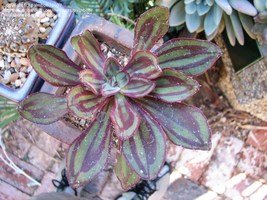
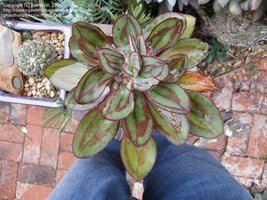 Echeveria nodulosas at different times of the year
Echeveria nodulosas at different times of the year
I don't have any Echeveria pulvinata in my yard, but I mention it because it is used in several very commonly sold hybrids that also have fuzzy leaves. It has leaves similar to Echeveria coccinea, though narrower, and can become similarly leggy in time. Full sun and/or cold/ drought can stress this species and make the leaves much more colorful with various shades of reds and pinks predominating.
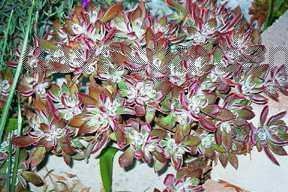
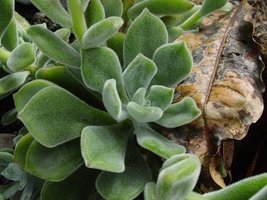 Echeveria pulvinatas photos: Kelli & htop
Echeveria pulvinatas photos: Kelli & htop

Echeveria pulvinata at cactus show, Los Angeles, showing amazing coloration
Echeveria purpusorum is a unique species looking very much like a Sempervivum species with its small overall size (2" in diameter usually), short, thick, pointed leaves and grey-green color fading to purples on the undersides. But the flowers are definitely Echeveria-like with tall arching inflorescences and bright pink-red and yellow flowers.
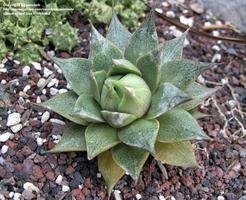
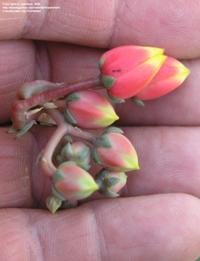
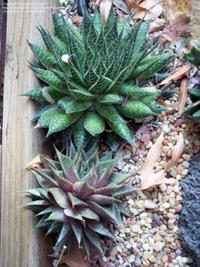
Echeveria purpusorum Echeveria purpusorum flower Echeveria purpusorum begining to split into two plants
Echeveria runyonii var Topsy Turvy is another extremely commonly sold species at most garden outlet centers. This variety has uniquely inwardly arching leaves with prominent ‘V's on the underside of the leaves (opposite to almost all over ‘V'-shaped leaves in the plant kingdom). The ‘normal' version of Echeveria runyonii is far less interesting having flat, pale blue-green leaves. For that reason, this plant is less common in cultivation (but still easy to find- just never identified as such). This species is a particularly prolific flowerer making up to 10 tall, arching, heavy inflorescences with pink and orange flowers. This is another of the ‘somewhat monocarpic' species with this massive flowering event seemingly to wipe of the mother plant leaving further spectacular flowering up to the offsets.
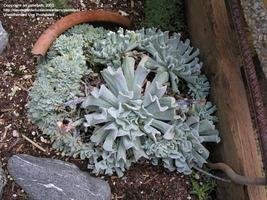
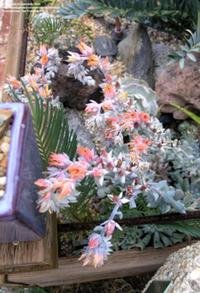
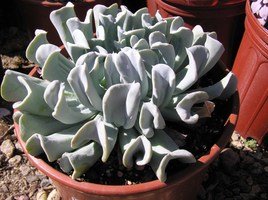
Plants suckering in my yard, and then flowering in massive numbers. Potted plant showing weird leaves

Echeveria runyonii 'Topsy Turvy' planting mass in planter box for sale
Echeveria setosa is another great fuzzy-leaved species. But unlike most other fuzzy Echeverias, this one does not form woody stems or ever get leggy. It is a squat bright green plant with very short triangular leaves with just the hint of pink at the tips. This is a species often confused with some of the fuzzier Sempervivums which have a similar compact look and leaf shape. Flowers will quickly identify this as an Echeveria though as a large, branched inflorescence emerges in spring with bright orange flowers tipped with yellow.
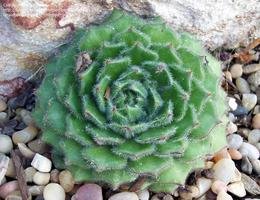
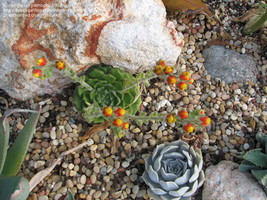
This Echeveria setosa is only about 2.5" in diameter. Flowering in second photo
Echeveria subrigida is a giant species that is probably the most attractive of all the Echeveria species (to me). It grows up to nearly 18" in diameter and the leaves are an amazing bright turquoise, wavy edged and lined with a hot pink coloration. Plants grown in any shade at all tend to stay green and are far less impressive in coloration. This is good to know as most nurseries will get them in green and usually charge less for them in this condition... but put them out in the sun and they will rapidly (several months) turn the magnificent turquoise that makes this one of the more pricey species.
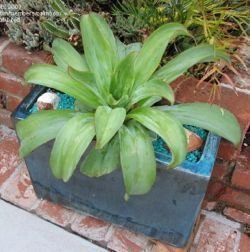
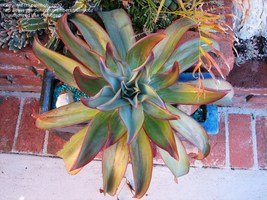
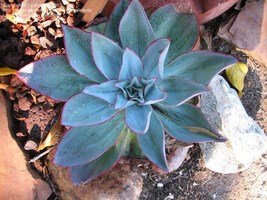
Color of plant at purchase (not been in full sun yet)... then turning it's 'true' sun colors Another plant that's been in sun a year
Here are some more species I have photographed, but I know less about these species:
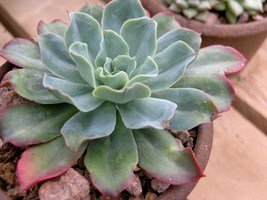
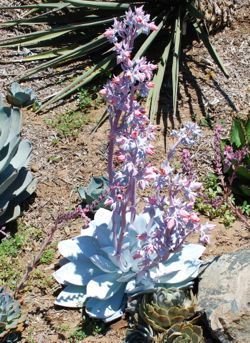
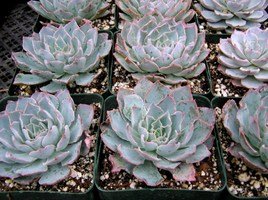
Echeveria Blue Bedder Echeveria cante Echeveria dondo
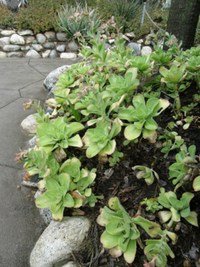
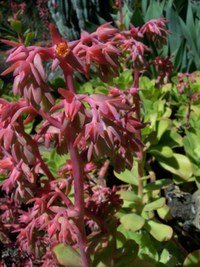
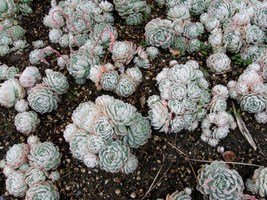
Echeveria pallida Echeveria pallida in flower Echeveria potosina (probably a form of Echeveria elegans)
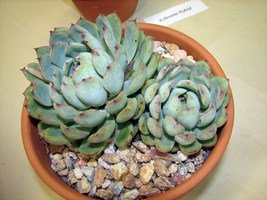
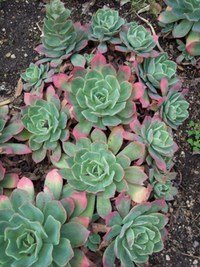
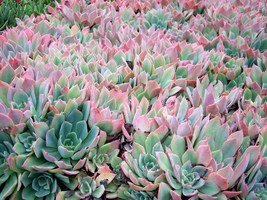
Echeveria pulidonis Echeveria pumilas
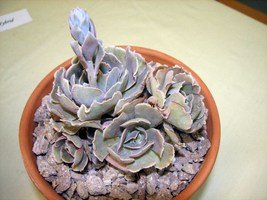
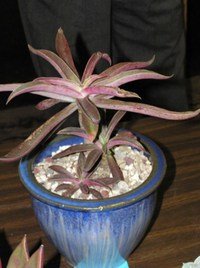
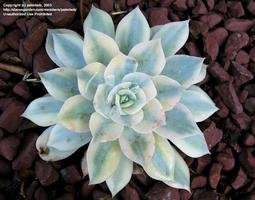
Echeveria shaviana Echeveria walpoleana Echeveria subsessilis
There are hundreds of Echeveria hybrids out there and I have dozens of them growing in my garden, but many of these hybrids are impossible for me to tell apart. Below are a few of my favorites, but I cannot guarantee I have them identified properly.
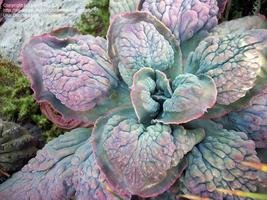
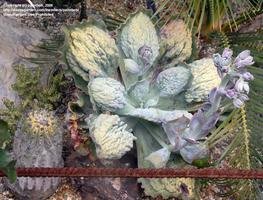
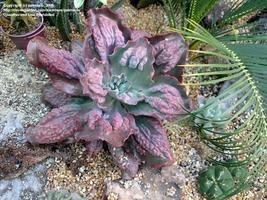
This is one of my favorite hybrids: Echeveria sp. 'Barbillion', though there are multiple similar hybrids. It's color changes tremendously from season to season, and it looks like it has cancer all the time. Eventually it grows too tall and has to be cut back and rerooted. Gets about 15" in diameter and is very easy.
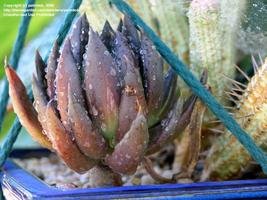
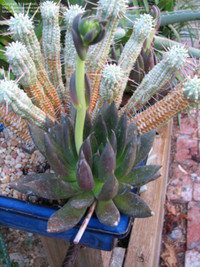 Echeveria Black Knight
Echeveria Black Knight
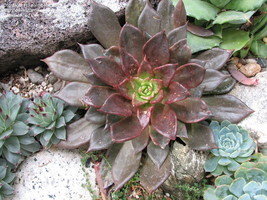
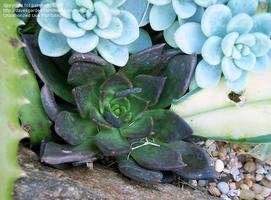
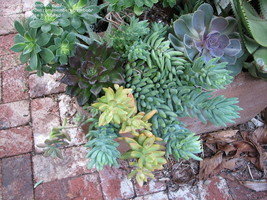
Both Echeveria Black Prince (above 3 photos) and Echeveria Black Knight are great constrasting species to grow in the garden. Both are fairly easy and very slow (if at all) to offset

Echeveria 'Black Princes' for sale
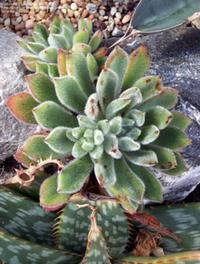
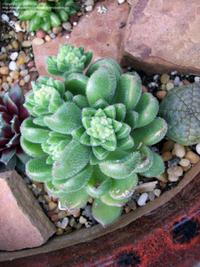
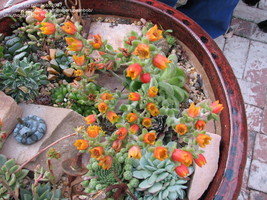
Echeveria Doris Taylor is an Echeveria setosa hybrid that is larger, and faster growing, and another easy plant
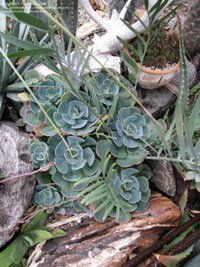
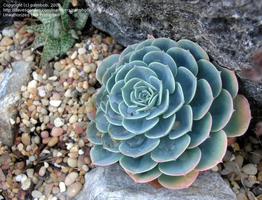

Another commonly grown hybrid is Echeveria Imbricata.. but I have to admit my inability to tell this hybrid from similar looking Echeverias. Undoubtedly one of the above plants is this hybrid, but unlike that all are.

Nusery Echeveria 'Imbricatas' for sale
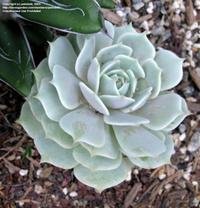
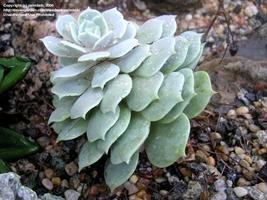
Echeveria Lola is another attractive mostly non-suckering hybrid, but not good for full sun
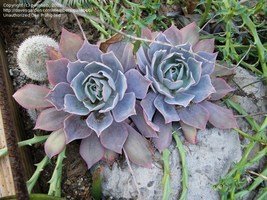
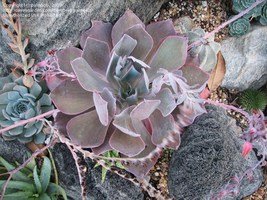
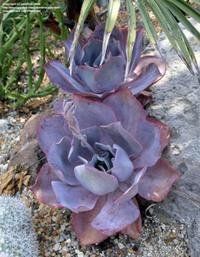
One of the very best and most spectacular hybrids for outdoor use is Echeveria Morning Light, a very hardy and ever-changing plant (sometimes it's blue, sometimes purple, sometimes pink, sometimes grey)
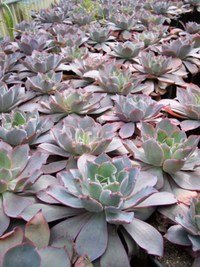
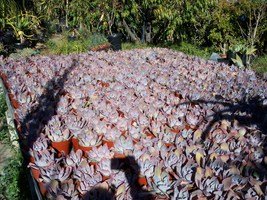 these are Echeveria Morning Lights at nurseries for sale
these are Echeveria Morning Lights at nurseries for sale
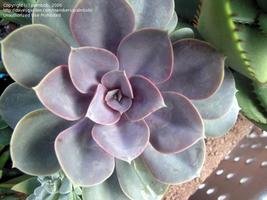
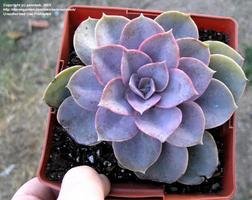
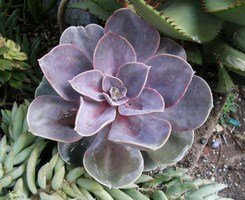
Echeveria Perle Von Nurmberg is another wonderful and easy hybrid that rarely offsets and tends to look perfect all the time

Echeveria 'Perle Von Nurmbergs' for sale at a nursery
Here are some more Echeveria hybrids one might run into in cultivation (just a few of hundreds)
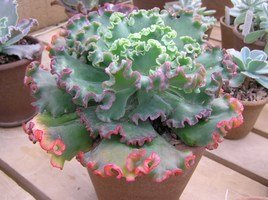
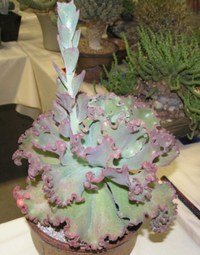
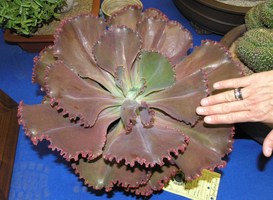
Echeveria Dick Wright Echeveria Etna Echeveria Strawberry Heart
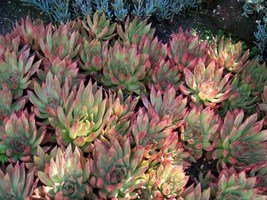
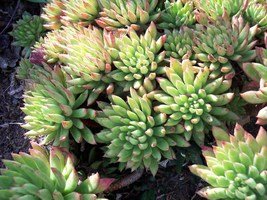
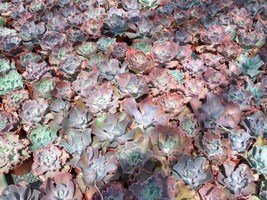
Echeveria agavoides hybrid Echeveria Set-Oliver Assortment of hybrids for sale
It is not always easy to identify an Echeveria as many other plants can mimic them (most are from different parts of the world, however). Here are some other Crassulaceae plants that mimic Echeverias and are fairly commonly encountered in cultivation... some are even commonly sold mistakenly as Echeverias by nurseries.
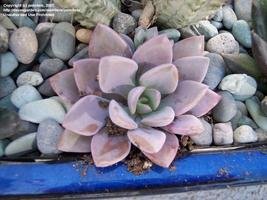
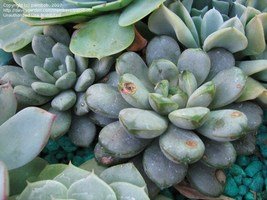
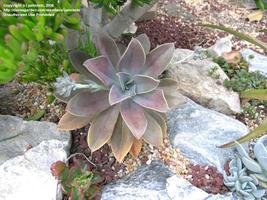
Graptoverias are intergeneric hybrids of Graptopetalums and Echeverias... above are Graptoveria Debbie, Graptoveria amethystinum and Graptoveria Fred Ives (that last one is one of the most prolific growers in my yard, both in terms of rapid growth, establishment from cuttings and offsetting- makes large (12" diameter) purple-orange rosettes and handles full sun very well.
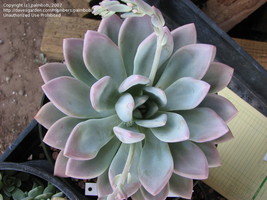
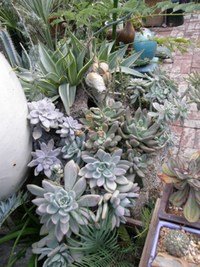
But by far my favorite Graptoveria is this one, Graptoveria Opalina, with thick, smooth turquoise/pink leaves (suckering in the second photo, along with another Graptoveria and two Graptopetalum species)
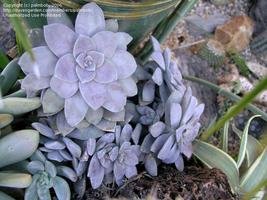
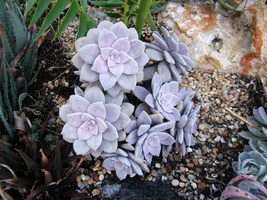
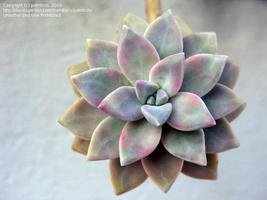
Graptopetalum pentandrums in my yard (first two photos) and Graptopetalum paraguayense in last photo. Both these are easy and attractively colorful species outdoors in full sun
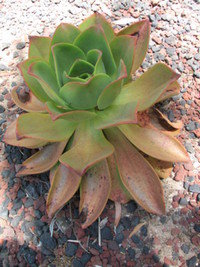
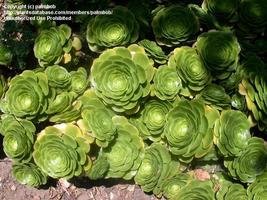
Aeoniums can sometimes be confused with Echeverias, being succulent rosettes... though most grow very tall on succulent stalks. These two do not and many confuse Aeonium nobile, and Aeonium pseudotabuliforme with Echeverias
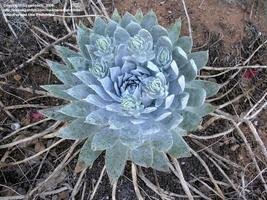
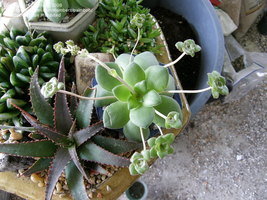
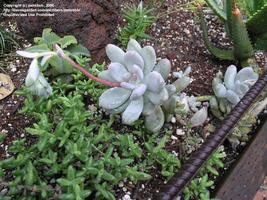
Dudleyas can sometimes look Echeveria-like (Dudleya brittonii), Crassulas rarely do, but this Crassula obicularis has rosettes similar to Echeverias, and this Pachyphytum sp. also could be confused with an Echeveria
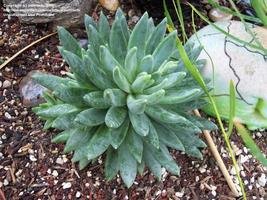
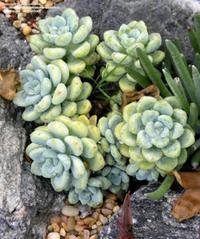
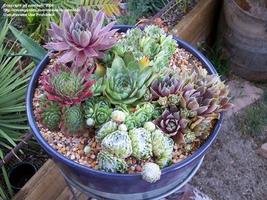
Pachyverias are another intergeneric hybrid (Pachyphytym and Echeveria); this Sedum clavatum in the middle photo is often sold as Echeveria clavatum... and of course, Sempervivums (the 'other' Hens and Chicks)
Lastly there are few Echeverias I have that are wonderfully ornamental, but which I cannot seem to pin down to a specific species... any help?
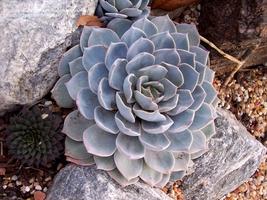
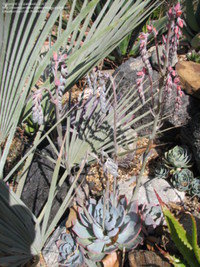
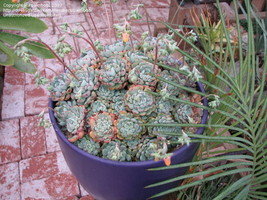
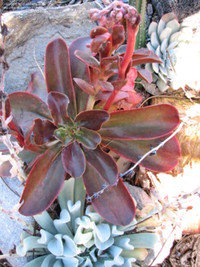
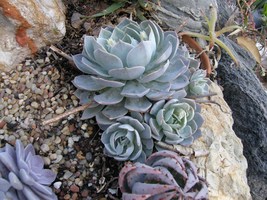
This red one I have identified as Echeveria fasciculata... but cannot really find much data to support that diagnosis.
For more on Echeverias, read John Pilbeam's book: The Genus Echeveria, 2008, published by the British Cactus and Succulent Society
Copyright © www.100flowers.win Botanic Garden All Rights Reserved